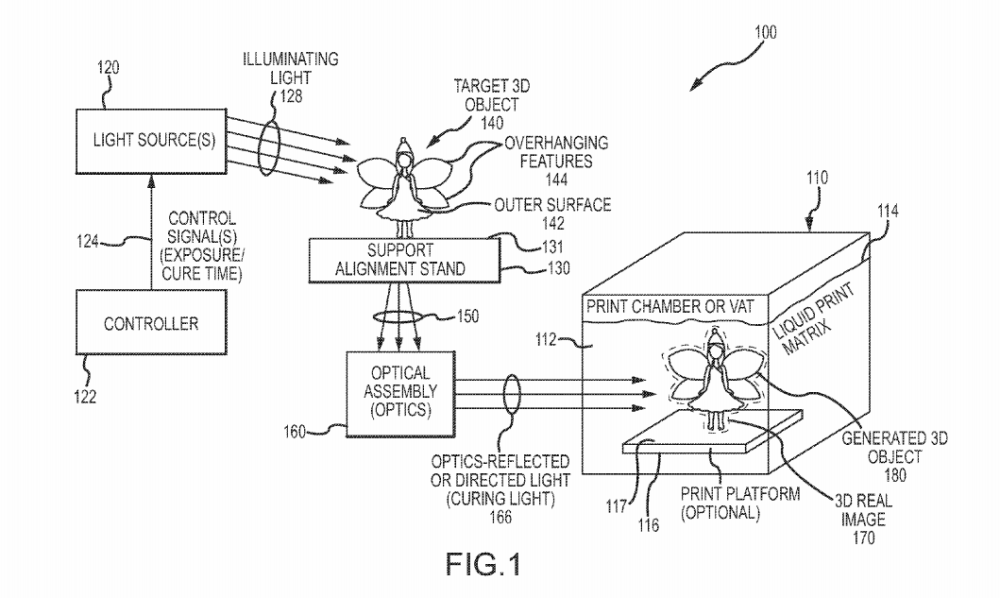Disney Research Just Invented a “3D Copier” That Uses Light-Cured Resin to Duplicate Entire Objects Instantly
 Using light-cured resins to 3D print physical objects is not a new technology. In fact, the oldest form of 3D printing is stereolithography (SLA), a process that uses a laser to harden individual layers of liquid resin until a full object is complete. Using a similar concept, direct light projection (DLP) actually uses a powerful light projector rather than a laser and is capable of printing an entire layer at a time. There are also superfast variations of this process like Carbon3D and their CLIP (Continuous Liquid Interface Production) technology and NewPro3D and their ILI (Intelligent Liquid Interface) process that can produce 3D models almost forty times as fast as standard SLA 3D printers.
Using light-cured resins to 3D print physical objects is not a new technology. In fact, the oldest form of 3D printing is stereolithography (SLA), a process that uses a laser to harden individual layers of liquid resin until a full object is complete. Using a similar concept, direct light projection (DLP) actually uses a powerful light projector rather than a laser and is capable of printing an entire layer at a time. There are also superfast variations of this process like Carbon3D and their CLIP (Continuous Liquid Interface Production) technology and NewPro3D and their ILI (Intelligent Liquid Interface) process that can produce 3D models almost forty times as fast as standard SLA 3D printers.
But it looks like even CLIP and ILI will seem slow in comparison to the new process that is described in a patent application filed last month by Disney Research. The patent technology is described as a new 3D printing technology that will print a fully 3D object all at once rather than layer-by-layer. The patent contains several different variations of the process, including one that would allow users to place a real world object on a designated capture platform and then duplicate it in a vat of liquid resin almost instantly. Another variation would project what is essentially a hologram of a 3D object into the vat of resin and then instantly solidify the outer shell. And another would allow for an object to have its outer shell solidified while concurrently having support structures or some other type of infill solidified. The process is described in the Disney Research patent application:
“Briefly, a 3D printer (and corresponding 3D print method) is described that is adapted for “printing” or generating a 3D object in a manner that circumvents the layer-by-layer approach of conventional 3D printers that has significantly limited achievable printing speeds. In one design approach, the 3D printer is configured with the assumption that a physical “original” of a 3D object already exists (not just a digital model of a 3D object). In this first 3D printer design, the 3D printer acts as a high speed copying machine because it uses an optical assembly or a set of optics that relays a volumetric real image (versus a virtual image) of the existing or target 3D object into a vat or container holding a volume of photo-curing liquid resin.”
Basically, Disney Research just invented the “3D Copier.” It’s a process that will be capable of what could be described as instantaneous 3D scanning and 3D printing. It calls for an object to be placed on a special platform that will have a series of lights projected on it. This will result in a three dimensional silhouette of the object, similarly to how a 3D laser scanner works. This 3D silhouette could then be projected in real time into a vat of liquid resin and almost instantly solidified into a duplicate of the original object. The patent application goes on to describe the process, defines how quickly the 3D object will be printed, the method of supporting the newly created 3D structure and its removal.
“The light associated with the volumetric real image, which is provided by one or more light sources directing light onto the existing or target 3D object, causes a portion or volume of the photo-curing liquid to be cured in a nearly instantaneous manner to generate or produce the entire 3D object (rather than slowly and layer-by-layer as with conventional 3D printers). The printed or produced 3D object, which is floating in or supported in the uncured liquid (e.g., a resin selected to be translucent to transparent to light and also viscous to support the in-process 3D object), can simply be lifted out of the vat/container. In several testing operations, a 3D printer using photo-curing liquids has been proven effective in generating 3D objects in several minutes or less rather than in several hours.”
In their application, Disney calls their new 3D copying process “3D Printing by Volumetric Addition Through Selective Curing of a Fluid Matrix”. The process can be used with several different types of resins that can be selected or formulated to contain photoinitiators that will only harden at specific wavelengths of light. It can use both visible or invisible, however they do mention that resins sensitive to invisible wavelengths don’t seem as affected by ambient light. Disney Research described several successful applications using different light sources, including blue light projected at a 450 nanometer (nm) wavelength, violet light projected at a 405nm wavelength and invisible ultraviolet light projected at a wavelength of 365nm. The type of resin selected will also determine the resolution and printing volume.
“[T]he resin acts to both absorb and transmit light at the curing wavelength. Higher absorption results in a faster rate of curing but also a shorter maximal curing depth. The maximal curing depth determines the size of the largest object that can be cured. High transmission results in a slower rate of curing but also a longer maximal curing depth. These two competing requirements mean that there exists a tradeoff between curing rate and the maximum cured object size.”
While the patent is detailed about the process, the specific types of technologies that are employed are left pretty vague, so there is really no when or if we’ll ever see this technology. While Disney has empowered their research division to explore and develop all kinds of technology, they tend to focus on things that can be applied to their existing business models, so it is unlikely that they’ll be manufacturing and selling 3D printers. A more likely scenario is that the technology will be used to create custom toys, say with visitors’ faces on them, that can be made instantly while the customer waits at their theme parks.
The patent application is pretty thorough, and as is typical for these types of documents the language is very deliberate and specific. That coupled with a lot of run on sentences means that it is going to be pretty hard to read, but if you’re so inclined you can check out a PDF of the seventeen-page document here. And you can learn more about Disney Research and some of their other cutting-edge projects on their website. Discuss in the Disney 3D Printer Patent Request forum over at 3DPB.com.
Subscribe to Our Email Newsletter
Stay up-to-date on all the latest news from the 3D printing industry and receive information and offers from third party vendors.
You May Also Like
Air Force Awards Fortius Metals $1.25M to Qualify 3D Printing Wire for Hypersonic Applications
AFWERX, part of the US Air Force Research Laboratory (AFRL), awarded a Direct-to-Phase II Small Business Innovation Research (SBIR) contract worth $1.25 million to Colorado’s Fortius Metals, to accelerate qualification...
US Air Force Awards JuggerBot $4M for Large-format Hybrid 3D Printing
Large-format 3D printer manufacturer JuggerBot has received a $4 million grant to develop a large format 3D printer, courtesy of the Under Secretary of Defense, Research and Engineering Manufacturing Technology...
Where Have All AM’s Unicorns Gone?
In the rapidly evolving world of 3D printing, startups valued at over a billion dollars, known as unicorns, once seemed as fantastical as the mythical creatures themselves. While a few...
How My Childhood Fascination with Planes Led to Investing in 3D Printing
My fascination with aerospace started young, and I started studying planes–identifying them in the sky and learning everything I could about how they work. Fast forward to my first week...


































